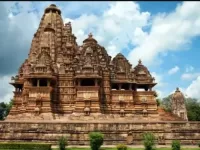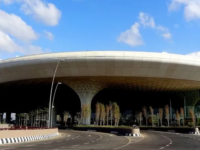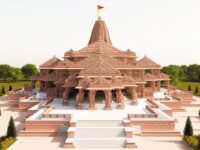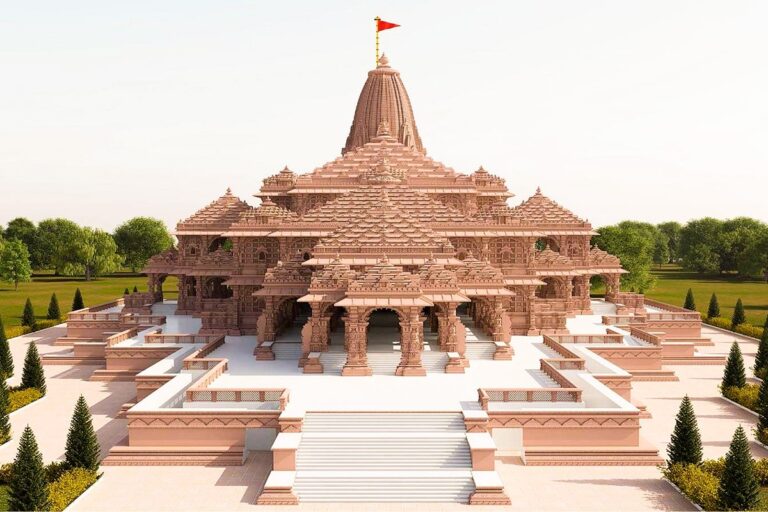Here are some key facts about the Ram Mandir (Ram Janmabhoomi Temple) in Ayodhya, Uttar Pradesh, India:
Let’s be real — there are temples, and then there’s Ram Mandir. The name itself brings to mind history, devotion, controversy, pride, and most importantly, faith.
Located in the ancient city of Ayodhya, Uttar Pradesh, this temple isn’t just a place of worship — it’s a story. A long one. A dramatic one. One that has been told, debated, and felt across generations. Whether you’re religious or not, whether you lean spiritual or logical, there’s no denying: Ram Mandir is a big deal.
So let’s dive in — no politics, just vibes — and talk about what makes Ram Mandir so iconic, so emotional, and so very Indian.
🌅 A Little Backstory: Ayodhya and Ram
First things first — let’s rewind.
Ayodhya isn’t just any city. It’s believed to be the birthplace of Lord Ram, the hero of the epic Ramayana, the seventh avatar of Vishnu, and a symbol of virtue, dharma, and kingly greatness.
According to Hindu belief, Lord Ram was born in Treta Yuga, in a palace that stood where the Ram Janmabhoomi (birthplace) is now marked. That land, over time, became the most spiritually significant site for Ram bhakts (devotees).
For centuries, pilgrims visited the site believing it to be sacred. But here’s where things start getting complicated — historically, politically, and emotionally.
🏚️ From Temple to Trouble: The Babri Masjid Saga
So, in the 16th century, Babur, the first Mughal emperor of India, is said to have built a mosque at this site — the Babri Masjid. Many Hindus believed it was built after demolishing a temple marking Ram’s birthplace. That belief sparked tensions that simmered over the years, occasionally flaring into protests, court cases, and eventually full-blown national debates.
Things escalated dramatically in 1992, when the Babri Masjid was demolished by a large group of kar sevaks (volunteers). The incident shook the country, sparking riots, political turmoil, and decades of legal battles.
The whole situation was painful and polarizing, with people on all sides expressing grief, anger, or confusion. But through it all, one thing remained constant — the belief in Ram and the hope that someday, a grand temple would rise at his birthplace.
⚖️ The Courtroom Drama: Years of Legal Tug-of-War
For over seven decades, the dispute over the land continued. Multiple parties claimed ownership. It became one of the most high-profile legal cases in Indian history.
Finally, in November 2019, the Supreme Court of India delivered a landmark judgment. It ruled that the land belongs to Hindus and allowed the construction of a Ram temple on the site. The court also directed that a separate piece of land in Ayodhya be allocated for the construction of a mosque.
The verdict was largely seen as a closure to a long-standing chapter. There were celebrations, but also calls for peace and unity — a moment where India paused, took a deep breath, and hoped to move forward.
🛕 The Dream Takes Shape: Ram Mandir Construction Begins
The foundation for the new Ram Mandir was laid on August 5, 2020, by Prime Minister Narendra Modi. The ceremony was deeply symbolic, attended by religious leaders, dignitaries, and covered live across the country.
But this wasn’t just a brick-and-mortar event. It was emotional. For many, it felt like the fulfillment of a centuries-old promise.
Since then, construction has been in full swing. And wow — what a temple it’s turning out to be!
🏗️ What’s the Temple Like? (Spoiler: It’s Epic)
The design of the Ram Mandir is straight-up stunning. Here are some cool deets:
- Architecture style: Traditional Nagara style, inspired by ancient Hindu temple architecture.
- Height: Around 161 feet tall.
- Length & Width: 360 feet long and 235 feet wide.
- Pillars: Over 360 intricately carved pillars.
- No steel: Yep, you read that right. The entire structure is being built with traditional stone, no steel at all.
- Materials: Made using pink sandstone from Rajasthan — the color gives it a majestic glow.
There’s a huge Garbhagriha (sanctum sanctorum) where the idol of Ram Lalla (child Ram) will be installed, plus multiple mandaps (halls), a grand stairway, and lush green spaces around the temple complex.
🧱 Ram Lalla Returns Home
For decades, the idol of Ram Lalla had been housed in a temporary tent-like structure, under heavy security and legal restrictions.
But in January 2024, during the Pran Pratishtha (consecration) ceremony, the idol of Ram Lalla was finally placed in the sanctum of the new temple. The ceremony was watched by millions around the world — a moment that felt both historical and spiritual.
For many devotees, it was a homecoming. For the country, it was a moment of cultural unity.
🚉 Ayodhya 2.0: Not Just A Pilgrimage Spot Anymore
With the Ram Mandir becoming a global spotlight, Ayodhya itself is transforming. It’s no longer just a sleepy pilgrimage town — it’s now buzzing with energy, tourists, and development.
The city is getting:
- A revamped Ayodhya railway station (modern, shiny, and Ram-themed)
- A brand new Ayodhya International Airport
- Better roads, hotels, and amenities
- Mega plans for a “spiritual tourism” hub
So yes, the city is all set to become a major destination on India’s spiritual and cultural map.
🙏 Why Ram Mandir Matters (Beyond Religion)
Whether you’re religious or not, it’s hard to ignore what Ram Mandir stands for:
- For many, it’s a symbol of faith triumphing over adversity.
- For others, it’s about reclaiming cultural identity.
- And for some, it’s just a beautiful architectural and spiritual marvel.
The temple has also sparked conversations about coexistence, tolerance, and the importance of resolving deep-rooted issues peacefully — something the world can always use more of.
✨ The Bigger Picture
At the end of the day, the Ram Mandir is not just a building. It’s a story — of belief, resilience, devotion, and the human longing for connection to something higher.
It’s proof that history may be messy, but the future can still be meaningful.
Whether you visit to pray, to admire the architecture, or to simply soak in the energy, Ram Mandir is one of those places that leaves a mark. Not just on your Instagram feed — but in your heart.
So, next time you hear someone talk about Ram Mandir, you’ll know — it’s not just about religion or politics or stone and mortar. It’s about legacy, faith, and the power of a dream that never gave up.
Jai Shri Ram! 🙏








































































































0 Comments